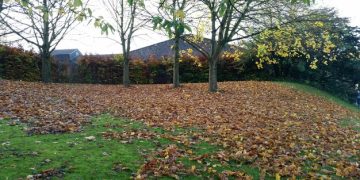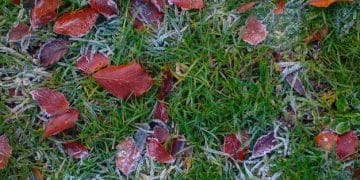Pruning for Success: A Step-by-Step Guide to Fruit Tree Pruning in Late Winter
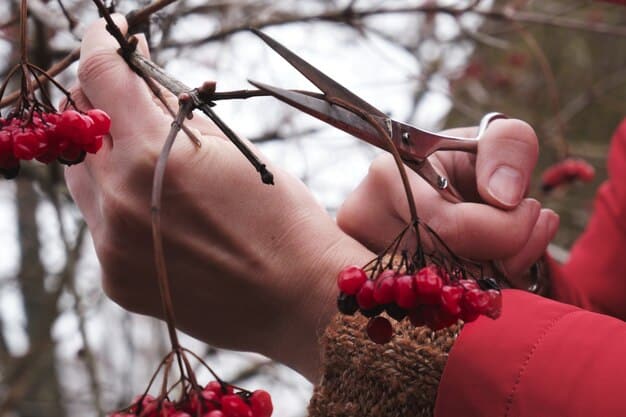
Pruning fruit trees in late winter is crucial for ensuring healthy growth and abundant fruit production. This step-by-step guide outlines the essential techniques, tools, and timing considerations for successful pruning, enabling both novice and experienced gardeners to maximize their fruit tree’s potential.
Late winter is the ideal time to prune most fruit trees, setting the stage for a bountiful harvest. This comprehensive guide, Pruning for Success: A Step-by-Step Guide to Pruning Fruit Trees in Late Winter, will walk you through everything you need to know, from selecting the right tools to making precise cuts.
Understanding the Importance of Late Winter Pruning
Pruning fruit trees might seem daunting, but it’s an essential practice for maintaining their health and productivity. Why late winter? Because the trees are dormant, making it easier to see their structure and make informed decisions about which branches to remove.
Late winter pruning also encourages vigorous new growth in the spring. By removing dead, diseased, or crossing branches, you’re directing the tree’s energy towards producing healthy fruit-bearing wood.
Benefits of Pruning in Late Winter
Pruning in late winter isn’t just a matter of aesthetics; it’s a strategic move that offers numerous benefits for your fruit trees. Understanding these benefits can motivate you to take on the task with confidence.
- Increased Fruit Production: Pruning helps to create an open canopy, allowing sunlight to reach all parts of the tree. This results in more even fruit ripening and better fruit quality.
- Improved Tree Health: Removing dead or diseased branches prevents the spread of infection and promotes overall tree health. This can extend the lifespan of your fruit trees.
- Enhanced Air Circulation: An open canopy also improves air circulation, which reduces the risk of fungal diseases. Good airflow helps to keep the tree dry and healthy.
- Easier Harvesting: Pruning can make it easier to harvest fruit by keeping the tree at a manageable size. This reduces the need for ladders and makes the picking process more efficient.
Ultimately, late winter pruning sets the stage for a healthy and productive growing season. It’s an investment that pays off in the form of delicious, high-quality fruit.
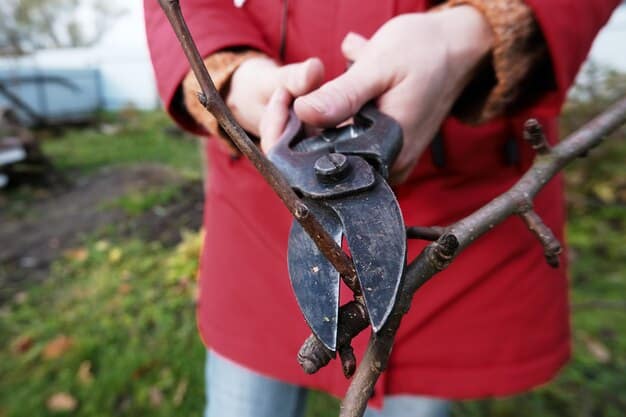
Essential Tools for Successful Pruning
Having the right tools is crucial for efficient and effective pruning. Investing in high-quality tools will not only make the job easier but also ensure clean cuts that promote healthy healing.
Here’s a breakdown of the essential tools you’ll need for pruning fruit trees in late winter. Each tool serves a specific purpose, so it’s important to choose the right one for the job.
Types of Pruning Tools
Selecting the right tool for the job is crucial to avoid damaging your fruit trees. Each type of pruning tool serves a specific purpose, ensuring clean cuts and healthy healing.
- Hand Pruners (Bypass): Ideal for small branches (up to ½ inch in diameter). Bypass pruners make clean, precise cuts, minimizing damage to the tree.
- Loppers: Used for branches between ½ inch and 2 inches in diameter. Loppers provide extra leverage, making it easier to cut thicker branches.
- Pruning Saw: For branches larger than 2 inches in diameter. Pruning saws are designed to cut through thick wood with ease.
- Pole Pruner: Allows you to reach high branches without using a ladder. Pole pruners are especially useful for larger trees.
When selecting pruning tools, look for durable materials, comfortable handles, and a design that suits your strength and hand size. Proper maintenance, such as cleaning and sharpening, will extend the life of your tools and ensure they perform optimally.
A Step-by-Step Guide to Pruning Fruit Trees
Now that you understand the importance of pruning and have the right tools, let’s dive into the step-by-step process. This section will provide a clear and concise guide to pruning your fruit trees effectively.
Remember to approach each tree with a plan. Take a few minutes to assess its overall structure and identify any problem areas before you start cutting.
Identifying Problem Branches
Before making any cuts, it’s important to identify which branches need to be removed. This will help you to create a clear vision for the tree’s future growth and productivity.
- Dead Branches: These are easy to spot and should be the first to go. Dead branches can harbor disease and attract pests.
- Diseased Branches: Look for signs of infection, such as discoloration, lesions, or unusual growths. Remove these branches to prevent the spread of disease.
- Crossing Branches: Branches that rub against each other can create wounds that are susceptible to infection. Remove one of the crossing branches to improve air circulation.
- Suckers and Water Sprouts: Suckers grow from the base of the tree, while water sprouts grow vertically from the branches. These non-fruiting shoots steal energy from the tree and should be removed.
By carefully identifying and removing these problem branches, you’ll create a healthier and more productive tree. Take your time and make informed decisions about each cut.
Pruning Techniques: Making the Right Cuts
The way you make your cuts is just as important as which branches you choose to remove. Incorrect cuts can damage the tree and hinder its ability to heal properly.
Here are some essential pruning techniques to ensure clean cuts and promote healthy growth.
Proper Cutting Techniques
Mastering proper cutting techniques is essential for promoting healthy healing and preventing disease. These techniques ensure clean cuts that minimize damage to the tree.
- Angle Your Cuts: When removing a branch, angle your cut slightly away from the bud or branch you want to encourage to grow. This promotes outward growth.
- Cut Close to the Collar: The branch collar is the slightly swollen area where a branch joins the trunk. Cut just outside the branch collar to allow the wound to heal properly.
- Avoid Stub Cuts: Leaving a stub can prevent the wound from healing and create an entry point for disease. Cut the branch flush with the branch collar.
- Make Clean Cuts: Use sharp pruning tools to make clean, smooth cuts. Ragged cuts can attract pests and diseases.
By following these cutting techniques, you’ll minimize damage to your fruit trees and promote healthy healing. Remember to take your time and focus on making precise, clean cuts.
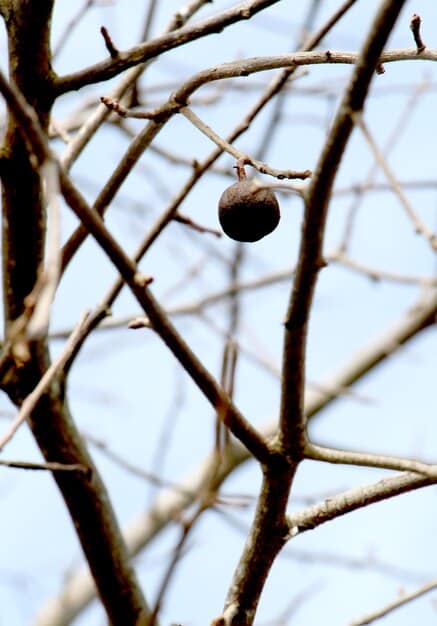
Specific Pruning Strategies for Different Fruit Trees
While the general principles of pruning apply to most fruit trees, different varieties have unique growth habits and require specific pruning strategies. Understanding these nuances is essential for maximizing fruit production.
For example, apple and pear trees are often pruned to an open-center or central-leader system, while peach and nectarine trees benefit from heavier pruning to encourage new fruit-bearing wood.
Pruning Apple and Pear Trees
Apple and pear trees are typically pruned to either an open-center or central-leader system. The goal is to create a strong framework with good air circulation and sunlight penetration.
- Open-Center System: This involves removing the central leader to create an open, vase-like shape. This allows sunlight to reach all parts of the tree.
- Central-Leader System: This maintains a dominant central trunk with branches growing outwards. This system is often used for trees that are naturally upright.
- Remove Upright Shoots: Focus on removing upright shoots that grow towards the center of the tree. These shoots can block sunlight and reduce air circulation.
- Encourage Horizontal Growth: Promote horizontal growth by cutting back branches to outward-facing buds. This will help to create a wider, more productive tree.
By tailoring your pruning techniques to the specific needs of apple and pear trees, you can maximize their fruit-bearing potential and maintain their overall health.
Maintaining Your Pruned Fruit Trees
Pruning is just one part of the puzzle. To ensure your fruit trees thrive, you’ll need to provide ongoing care and maintenance throughout the year.
This includes fertilizing, watering, pest control, and monitoring for signs of disease. A well-maintained tree is a healthy and productive tree.
Post-Pruning Care
After pruning, it’s important to provide your fruit trees with the care they need to recover and thrive. This includes fertilizing, watering, and protecting them from pests and diseases.
- Fertilize: Apply a balanced fertilizer in the spring to provide the tree with the nutrients it needs for new growth.
- Water: Water deeply during dry periods, especially when the tree is actively growing.
- Monitor for Pests and Diseases: Regularly inspect your trees for signs of pests or diseases. Take action promptly to prevent problems from escalating.
- Mulch: Apply a layer of mulch around the base of the tree to help retain moisture and suppress weeds.
By providing consistent care and attention, you can ensure your fruit trees remain healthy and productive for many years to come. Remember that pruning is an ongoing process, so continue to monitor your trees and make adjustments as needed.
| Key Point | Brief Description |
|---|---|
| 🗓️ Timing | Late winter is the best time for pruning most fruit trees as they are dormant. |
| ✂️ Tools | Use sharp hand pruners, loppers, and a pruning saw for different branch sizes. |
| 🌳 Techniques | Remove dead, diseased, and crossing branches. Angle cuts away from buds. |
| 🍎 Benefits | Pruning improves fruit production, tree health, and air circulation. |
Frequently Asked Questions
▼
Late winter is ideal because trees are dormant, making branch structure visible. Pruning then encourages robust spring growth and maximizes fruit yield by directing energy efficiently.
▼
Essential tools include hand pruners for small branches, loppers for medium-sized branches, and a pruning saw for larger branches. Ensure tools are sharp for clean cuts.
▼
Focus on removing dead, diseased, or crossing branches. Also, prune water sprouts and suckers, which drain energy from the tree without producing fruit.
▼
Angle your cuts slightly away from buds to encourage outward growth. Cut close to the branch collar, but avoid leaving stubs. Use sharp tools for clean cuts that heal properly.
▼
After pruning, fertilize and water the tree. Monitor for pests and diseases. Apply mulch to retain moisture and suppress weeds, ensuring a healthy recovery and growth phase.
Conclusion
Pruning for Success: A Step-by-Step Guide to Pruning Fruit Trees in Late Winter, provides insights and practical steps for pruning success, offering a roadmap to rejuvenate fruit trees effectively. With the right knowledge, tools and timing, any gardener can look forward to bountiful harvests.

